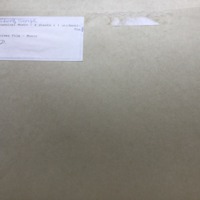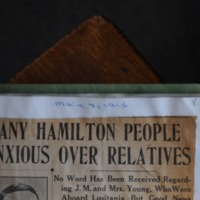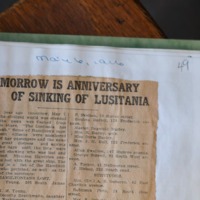George Sidwell
George Sidwell
Sidwell's work was focused on the writing and publishing of patriotic songs, as well as some sacred works. Born in 1865 in England, his life in Hamilton began in 1911 and ended with his death on the Lusitania in 1915. There is no documentation of his employment as a church organist ("Bicentennial Branch Events"). Sidwell was passenger #1574 on the Lusitania, and the full passenger list can be found here. A newspaper clipping states he resided at 92 South West Avenue Hamilton, Ontario before his death. The closest church to his location at his time of residence was St Patrick Church, a Roman Catholic establishment. Given his focus on chant in this collection, it is a candidate for employment or a composition commission.
Quadruple Chants
The chant, when used in religious worship, is made of repeated notes, often for the purpose of highlighting the text. In Sidwell's "Quadruple Chants", both his harmonic choices and his attention to notation style suggest that this setting could have been applied to multiple different texts. As the church calendar cycled through scripture, this work could have been applied as needed to supplement service music. What is most interesting about this work are the penciled-in edits: either someone besides Sidwell was accommodating the music to their own needs, or this was not the final draft of the work and Sidwell himself was making edits. Should the first be true, the work was cycling through a worship service without being published.
Collection of Liturgical Music
These samples are unpublished in this format.
George Sidwell’s work in this collection include sketches of “unidentified” music (according to the label on the archives file). The manuscript paper looks similar to that of how a church organist or choir director would write a psalm refrain, assigning one syllable per note and writing a SATB arrangement for a choir to sing. The Kyrie is also written in this fashion, with the expansion of the text of the Kyrie of the Mass Ordinary: “Lord, have mercy, Christ, have mercy. Lord, have mercy”. The sample’s text is illegible in the second system, ending with: “we beseech thee”. The practice of composing service music or psalm refrains for a specific church is often practiced by music directors or organists. His “liturgical music” is not in published form; thus, only speculation is applicable when considering these works. The third sketch, titled “He that hath pity”, appears to be an unfinished or experimental work. Because the stems are all facing the upwards position and the systems of music each having a treble clef, it looks in its current state to be SSA or an uncomplete SSAA. The final page is a two-system composition of SATB harmonies with no text. This appears to be (or is similar to) the practice of setting a psalm or litany with multiple verses to the same harmony, and printing the text below the music. The text is notated to allow the singers to determine when to move to the next note. The double barline supports this theory because it divides the music into sections for verses and refrains, or even a doxology.


